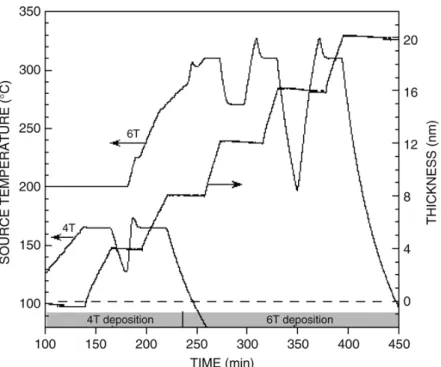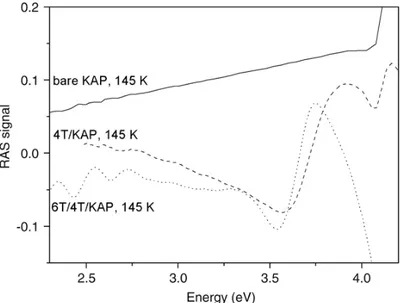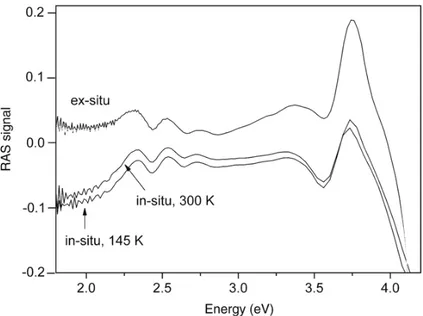and sharing with colleagues.
Other uses, including reproduction and distribution, or selling or licensing copies, or posting to personal, institutional or third party
websites are prohibited.
In most cases authors are permitted to post their version of the article (e.g. in Word or Tex form) to their personal website or institutional repository. Authors requiring further information
regarding Elsevier’s archiving and manuscript policies are encouraged to visit:
Superlattices and Microstructures 44 (2008) 550–555
www.elsevier.com/locate/superlattices
In-situ study of the interface formation in
organic multilayers
A. Sassella
a,∗, A. Borghesi
a, M. Campione
a, L. Raimondo
a, C. Goletti
b,
G. Bussetti
b, P. Chiaradia
baDepartment of Materials Science, University of Milano Bicocca, via Cozzi 53, I-20125 Milano, Italy bDepartment of Physics, University of Roma Tor Vergata, via della Ricerca Scientifica 1, I-00133 Roma, Italy
Available online 26 March 2008
Abstract
Organic molecular beam epitaxy (OMBE) is the growth technique assuring high quality films and properly designed multilayers of organic molecular materials in view of both their fundamental studies and applications. To monitor in-situ the OMBE growth, we have applied reflectance anisotropy spectroscopy (RAS), which is particularly effective and sensitive, being non destructive for organic materials. In this work, RAS is used to monitor, in-situ, the growth of organic heterostructures. The experiment is carried out using organic single crystals as substrates and oligothiophenes as molecular materials to build a stack of layers. A layer-by-layer growth of the films is demonstrated, together with the formation of interfaces with peculiar optical behavior and structure.
c
2008 Elsevier Ltd. All rights reserved.
Keywords:Organic semiconductors; Organic MBE; In-situ optical monitoring; Organic heterostructures
1. Introduction
Organic molecular semiconductors have received a renewed interest in recent years thank to their successful application in various semiconductor devices, integrated as films or within properly designed multilayers. When dealing with research on organic semiconductors, their possible applications, and the related technologies, one of the main problems rests on how to control the molecular arrangements of molecules in the solid state to make the semiconductor exploiting its properties in the best way. Indeed, carrier mobility, which is still the main limit
∗Corresponding author. Tel.: +39 02 64485160; fax: +39 02 64485400.
E-mail address:[email protected](A. Sassella).
0749-6036/$ - see front matter c 2008 Elsevier Ltd. All rights reserved. doi:10.1016/j.spmi.2008.02.002
A. Sassella et al. / Superlattices and Microstructures 44 (2008) 550–555 551
of these materials, is strongly enhanced when a high degree of structural order and good morphology and surface quality are reached. In this respect, the use of a highly controlled growth technique together with the availability of suitable in-situ monitoring techniques allows an important progress. For this purpose, organic molecular beam epitaxy (OMBE [1]) systems are the best choice as film deposition apparatuses, given the control they offer on purity, thickness, growth rate, surface morphology, and structure of the growing samples. On the other hand, optical techniques are the most suitable in-situ monitoring tools for OMBE applications, combining high sensitivity to thickness and electronic properties of the layer and a gentle interaction of the probe with the soft matter. In fact, it should be noted that electron diffraction techniques (typically used for in-situ monitoring of the film growth in inorganic MBE) are destructive for organics. In this respect, reflectance anisotropy spectroscopy (RAS [2]) was demonstrated by the authors to offer an excellent choice [3], which enables monitoring the film growth with very high sensitivity (down to submonolayer resolution), studying its growth mode, checking its homogeneity over large areas, and investigating the formation of all the interfaces between substrate and film and between subsequent films in multilayers.
In this paper, we discuss the OMBE deposition of oligothiophene multilayers (namely made of, alternatively, quater- and sexi- thiophene, 4T and 6T) onto a crystalline organic substrate. After the presentation of the high control reached on the growth process of the complete heterostructure, the evolution of the RAS spectra collected in-situ with film thickness and composition is discussed. Finally, the RAS signal collected under different conditions after growth is considered to check the stability of the all-organic multilayer structure.
2. Experiment
Commercial 6T [4] was purified by several sublimation cycles, while 4T was synthesized and purified following a recently optimized procedure [5]. Commercial potassium hydrogen phthalate (KAP) single crystals [6] used as substrate were cleaved in air along the (010) plane before introduction into the OMBE chamber. Deposition of 4T and 6T thin films was carried out by OMBE under ultra-high vacuum (UHV, better than 5 × 10−10Torr), using Knudsen-type effusion cells. Deposition temperatures were 165 ◦C for 4T and 310◦C for 6T, and deposition rate was about 0.3 nm min−1. The film thickness and growth rate were monitored by a quartz microbalance installed close to the substrate and calibrated for 4T [7]; the substrate temperature was kept constant at −128◦C(145 K) during multilayer growth.
RAS spectra were measured at near normal incidence in the spectral range from 1.5 to 5 eV, with 20 meV resolution, using a home-made experimental apparatus installed on the OMBE chamber, equipped with a quartz strain-free window. Two Glan–Taylor prisms (polarizer and analyzer, see Ref. [3]) are used to make the technique sensitive to the sample birefringence [12]. A more detailed discussion of RAS and its application to organics can be found elsewhere [2,
3]. RAS measures the anisotropy of light reflected by a sample for two orthogonal directions of the linear polarization of the incident beam, here labeled a and b. The signal is expressed as: ∆R/R = 2(Ra − Rb)/(Ra + Rb), where Ra(Rb) is the light intensity reflected by the sample
for light linearly polarized along the a (b) direction. During the present experiment, a and b are nearly parallel to the h001i and h100i directions, respectively, of the KAP substrate crystal. 3. Results and discussion
Fig. 1illustrates the growth experiment, with the temperature of the two sources and the total sample thickness as a function of time. At first, the source for 4T is heated up to 165 ◦C and
Fig. 1. Temperature of the 4T and 6T sources (lower and upper curves) and film thickness during OMBE deposition of the complete heterostructure. The two steps of 4T deposition are carried out at 165 ◦C, while the three steps of 6T deposition are carried out at 310◦C. Between two deposition steps, when the complete RAS spectra are collected, the shutter is closed (so that the thickness remains constant) and the sources are cooled down by about 40◦C to stop sublimation, limiting material loss.
maintained at that temperature while depositing the first 4 nm thick film (see the 165◦C plateau in the 4T temperature curve and the thickness increase up to 4 nm in the thickness curve, centered around 150 min). Then, during the time interval of about 40 min necessary for collecting the RAS spectrum, the 4T beam was stopped and the source was cooled down to avoid loss of material, then heated up again for the second step of deposition of further 4 nm of 4T (starting around 200 min). During these operations, the 6T source was prepared, so that at about 260 min it was ready for the first step of deposition of 4 nm of 6T (see the corresponding temperature plateau and thickness increase); in the meanwhile, the 4T source was cooled down. After each stop, to start the new deposition step the cell was opened after a small delay to avoid any effect of the temperature overshoot visible in the temperature curves. This effect is unavoidable when the cells are cooled down and heated up at such a pace. Finally, following the same procedures the last two deposition steps of 4 nm of 6T were carried out (at about 330 min and 380 min), always with a beam stop for the time intervals necessary for collecting the RAS spectra. Two characteristics of the OMBE process can be clearly observed in Fig. 1, i.e. the constant deposition rate for both materials (slightly higher for 6T) and the constant source temperature during growth. Such parameters are connected to each other and both are relevant for the fine control of the film nucleation and growth mode [8].
The most significant RAS spectra in regards the growth and properties of the whole heterostructure (i.e. a multilayer structure made of three different materials, the KAP substrate, 4T and 6T), are reported in Fig. 2. The spectrum of the bare KAP substrate at 145 K inside the OMBE chamber (full line) was collected at the beginning of the experiment. As KAP is transparent in the range analysed, its RAS spectrum does not show any particular spectral features before the sharp absorption edge at about 4.1 eV. The combined effect of KAP birefringence and thickness produces characteristic oscillations in the signal below about 2.2 eV (seeFig. 3; For a
A. Sassella et al. / Superlattices and Microstructures 44 (2008) 550–555 553
Fig. 2. In-situ RAS spectra of : (i) the bare KAP substrate before deposition (full line), (ii) the sample after two deposition steps of 4T (total thickness: 8 nm of 4T, dashed line); (iii) the complete heterostructure after the last three deposition steps of 6T (total thickness: 8 nm of 4T + 12 nm of 6T, dotted line).
detailed discussion, the reader should read Refs. [3] and [9]). The KAP response is therefore a nearly flat line above 2.3 eV.
The dashed spectrum in Fig. 2 has been measured after 8 nm of 4T were deposited on KAP (in two steps, 4 nm each). It clearly shows the structure at about 3.6 eV characteristic of the 4T film grown on KAP at low substrate temperature [9] (close to that of the low temperature polymorph [10]), with (001) as contact plane. The dielectric response of crystalline 4T [9,11] permits assignment of this peak to a contribution of the dielectric function of mixed transversal–longitudinal character, while its negative sign suggests that the a4T(b4T) axis of the
4T crystal in the film is aligned with the β(α) reference direction of the RAS apparatus. The growth characteristics assure [9] that the 4T film grows layer-by-layer, i.e. each molecular layer is completed before the second one starts growing, and it is flat at a molecular level [9], thus being a perfect substrate for further growth of the 6T layers that complete the heterostructure.
The dotted spectrum in Fig. 2 has been collected on the complete multilayer, after growth of 12 nm of 6T (in three steps, 4 nm each). Some peculiar features are observed here, partly different from what observed during direct deposition of 6T on KAP [12]. The first characteristics related to the growth of the 6T layers is the positive peak centered at about 3.4 eV, which we attribute to the known response of crystalline 6T crystal as well as of a 6T film deposited on KAP [12,13]. In this regard, the meaning of such a feature is analogous to the peak at about 3.6 eV discussed above for 4T (that is still visible, although slightly modified in shape and spectral position). Moreover, its sign suggests the orientation of the 6T crystalline film unit cell with respect to the reference α and β directions of RAS (and of the substrate 4T film). A second characteristic is constituted by the small bands appearing in the range 2.4–2.8 eV. Both interference and birefringence have been ruled out as origin of these bands by considering the experimental conditions (predictable thickness of the layer giving interference, independence of the spectra of the presence of a second polarizer). In fact, these bands, separated by 0.19 eV, can be attributed to vibronic excitons originating from Frenkel excitons coupled to one effective vibrational mode [11,13]. This attribution suggests a very interesting interpretation: these bands come from a purely transversal response of the 6T crystalline film, probably given by a part of the 6T film oriented with a different contact plane with the 4T/KAP substrate. A possible explanation
Fig. 3. RAS spectra of the complete heterostructure, collected: (i) in-situ immediately after growth at 145 K; (ii) in-situ after the complete heating up to 300 K; (iii) ex-situ after few days at room temperature in air.
of this additional 6T crystal growth mode rests on the tendency of the first molecules reaching the substrate to assume the alignment parallel to the surface [14], which was then maintained during growth of a rather thick film. If this is the correct picture, the response should originate from the very first molecular layers at the interface with the 4T layer underneath. Obviously, we need support from the study and simulation of the molecular arrangement at the interface. Nevertheless, this result could open intriguing possibilities for the peculiar charge transport properties of such an interface.
To complete the discussion about growth and characteristics of the 6T/4T/KAP heterostructure, in Fig. 3 we present experimental evidence of its stability. The three reported RAS spectra were collected on the same sample: (i) in-situ, immediately after growth (same spectrum as inFig. 2); (ii) in-situ, after heating of the sample up to room temperature; (iii) ex-situ, after a few days during which it was stored in atmosphere at room temperature. The effect of heating to 300 K (which is a sort of mild annealing) is very small and may be explained in terms of the slightly different alignment of the optical apparatus when the temperature of the sample (and of the bulky sample holder) changes. Similar effects are detected ex-situ: since the ex-situ spectrum has been measured with a different RAS apparatus (one polarizer-version, see Ref. [3]; no UHV window; the sample could be oriented easily) and a new optical alignment, little differences in lineshape and intensity with respect to previous spectra measured in UHV at 145 K and at 300 K are expected and unavoidable. However, it is remarkable that all the RAS spectral features are not modified in energy position and intensity. Both the 4T and the 6T response are clearly visible and unchanged, showing the high stability of the whole heterostructure, that maintains the characteristic molecular arrangements at the interface discussed above.
4. Conclusions
Following the experimental evidence (given in previous papers) that the homo- and hetero-epitaxial growth of organic molecular layers are possible, here the growth of an all-organic heterostructure of 4T and 6T on KAP is presented, clearly assessing its high stability in temperature and time. The peculiar optical spectrum detected in-situ for the 6T layer growing on 4T opens some important questions on how the 6T molecules arrange on the underlying 4T
A. Sassella et al. / Superlattices and Microstructures 44 (2008) 550–555 555
surface and which 6T polymorph is growing. Both issues are under investigation, possibly with the support of new crystallographic data and arguments.
Acknowledgements
The authors gratefully acknowledge A. Papagni and S. Trabattoni for 4T synthesis and for purification of 4T and 6T. One of the author (L.R.) thanks Sovvenzione Globale Ingenio for financial support given by Fondo Sociale Europeo, Ministero del Lavoro e della Previdenza Sociale and Regione Lombardia.
References
[1] S.R. Forrest, Chem. Rev. 97 (1997) 1793.
[2] P. Weightman, et al., Rep. Progr. Phys. 68 (2005) 1251. [3] C. Goletti, et al., Org. Electron. 5 (2004) 73;
C. Goletti, et al., J. Phys. Condens. Matter 16 (2004) S4393. [4] Sigma Aldrich.
[5] S. Trabattoni, et al., J. Mater. Chem. 14 (2004) 171. [6] EKSPLA UAB, Lithuania.
[7] M. Campione, et al., J. Vac. Sci. Technol. A 22 (2004) 482. [8] A. Sassella, et al., Chem. Phys. 325 (2006) 193;
M. Campione, et al., J. Am. Chem. Soc. 128 (2006) 13378. [9] A. Sassella, et al., Phys. Rev. B 71(R) (2005) 201311. [10] T. Siegrist, et al., Adv. Mater. 10 (1998) 379.
[11] M. Laicini, et al., Phys. Rev. B 71 (2005) 45212. [12] C. Goletti, et al., Appl. Phys. Lett. 83 (2003) 4146. [13] S. Tavazzi, et al., J. Chem. Phys. 124 (2006) 194710. [14] S.C. Veenstra, et al., Thin Solid Films 422 (2002) 104.


